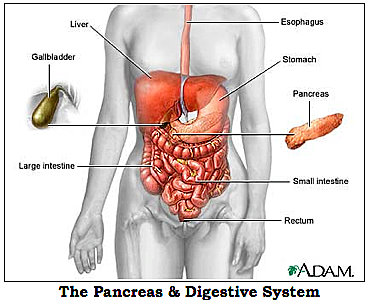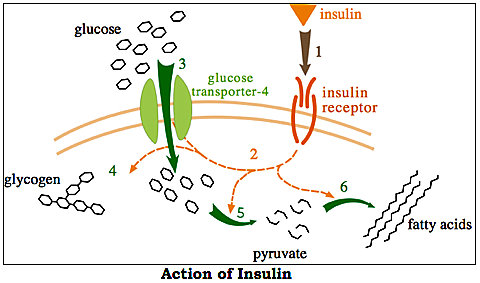Let’s Talk!
We are facing a global epidemic of diabetes, with an estimated 285 million people affected by this disease. In Canada, more than 3 million Canadians are diabetic and this number may rise to 3.7 million by 2020.
90% of diabetics suffer from Type 2 diabetes. This form of the disease is mostly linked to unhealthy lifestyle choices (i.e., poor nutrition and low physical activity) and can be debilitating. Especially in men, diabetes may have a significant impact on their sexual health.
Diabetes mellitus refers to all conditions of high blood sugar (hyperglycemia) and involves the pancreas. The pancreas is a gland organ of the digestive and endocrine system located behind the lower part of the stomach (see diagram below).
The pancreas produces many important hormones, including insulin, glucagon, and somatostatin. This gland also makes pancreatic juice that contains digestive enzymes that pass to the small intestine. These enzymes contribute to the breakdown of carbohydrates, protein, and fat. There are four types of pancreatic cells (α, β, δ, PP), but only the β cells produce insulin.
When we ingest food (especially carbohydrates), our blood sugar (glucose) rises and insulin is released into the blood stream. Insulin enables glucose to be absorbed into the cell through a glucose transporter imbedded in its membrane (see diagram below). Insulin is essential to life because although the body can use protein and fat as sources of energy, the brain is totally dependent on glucose.
Type 2 diabetes is a metabolic disorder characterized by relative insulin deficiency and insulin resistance. In other words, although the pancreas produces some insulin, the cells do not respond adequately to the hormone. The blood sugar that should normally be 4-6 mmol/L before meals, is now ≥7 mmol/L.
The rise in Type 2 diabetes cases is closely linked to the dramatic increase in obesity in North America. In Canada, 51% of Canadian adults are overweight, of which 17% are obese (i.e., have a Body Mass Index of at least 30).
An increase in deep abdominal body fat (i.e., visceral fat) leads to a pancreas that is surrounded by fat. In this condition, the pancreas tends to malfunction and insulin production is compromised. The excess circulating fat stimulates the production of low-density lipoprotein (i.e., LDL [bad cholesterol]) by the liver. Also, the liver is less able to clear the insulin produced by the pancreas.
Excess fat cells promote inflammation and reduce tissue sensitivity to insulin. The pancreas can overcompensate by producing even more insulin, but blood sugar still rises. The cells do not get the necessary glucose and starve. The “sugar-loaded†blood moves slowly through the body, leading to poor circulation/wound healing and, at times, amputations.
The common symptoms of Type 2 diabetes are frequent urination, increased thirst, dizziness, confusion, and hunger. The affected person may also have acetone breath due to the fact that the body uses fat as its main energy source.
Poorly managed Type 2 diabetes can lead to high cholesterol (LDL), heart attacks, blindness, kidney failure, strokes, dementia, cancer, and erectile difficulty (ED) in men.
The erectile difficulty is three times more common in diabetic men than healthy men. ED is defined as “the persistent inability to get or maintain an erection that is satisfactory for sexual activity.â€
High blood sugar damages the blood vessel walls and nerve cells. Consequently, there is less blood flow to the penis and diminished nerve sensitivity. Also, nitrous oxide production is reduced, leading to less vasodilatation and erections.
Testosterone (a male hormone) level in obese men tends to drop, leading to lower libido. It has been theorized that the excess fat cells may increase the conversion of testosterone to estradiol (a female hormone).
The sexual health of diabetic men is compounded by the fact that Type 2 diabetes is more prevalent in men aged forty and older. As we age, the body’s metabolism tends to slow down and excess weight gathers in men’s abdomen. Also, diabetic men often suffer from high blood pressure, and the medications used to control this problem increase the risk of ED.
ED can be an emotionally difficult problem for the affected men. The inability to maintain a satisfactory erection may exacerbate pre-existing body image issues. Drugs used to treat depression (i.e., serotonin reuptake inhibitors) can, in turn, reduce interest in sex.
Never before have we seen such an epidemic of excess weight and obesity in North Americans. Consequently, Type 2 diabetes is also on the rise, and this disease compromises the sexual health of the affected men. Unhealthy lifestyle choices rather than genetics are the main cause of this type of diabetes. Fortunately, diabetics can make simple dietary and exercises regimen changes that can regularize their blood sugars and maintain healthy sex lives.
Literary Truths
Here are some lifestyle and diet recommendations to better manage or prevent Type 2 diabetes:
- Exercise: Engage in at least 30 minutes of exercise daily. Physical activity helps to lose weight and increases the body tissue’s sensitivity to insulin.
- Stop smoking: Smoking increases the risks of heart attacks and strokes. Blood vessels contract and this contraction slow down blood circulation.
- Decrease unhealthful fats: Excess saturated fats (i.e., fats solid at room temperature) increase blood levels of low-density lipoprotein (the bad cholesterol). Trans fats from hydrogenated oils increase LDL and lower high-density lipoprotein (the good cholesterol). Unhealthful fats increase the risks of heart attacks and strokes.
- Increase healthful fats: Polyunsaturated and monounsaturated fats found in foods such as nuts, seeds, salmon, mackerel, olive oil, and avocados reduce the risk of heart attacks and strokes.
- Increase fiber intake: Increase daily intake of fiber to 20 g/day from whole grain, whole wheat, fruits, and vegetables. Soluble fiber is particularly good for lowering LDL. Insoluble fiber combined with protein increase the feeling of satiety, which helps decrease hunger and control body weight.
- Increase anti-angiogenesis food intake: Certain foods prevent the growth of blood vessels. Since fat cells need an abundant blood supply to grow, eating these foods help keep a leaner body. Examples include: Vitamin E, Earl Grey, and green teas, garlic, berries, and cooked tomatoes.
- Control stress: Emotional stress releases hormones such as cortisol and norepinephrine that stimulate the release of glucose into the bloodstream. Relaxation exercises, such as meditation and deep breathing, may help relax the mind and lower blood sugars.
Truth in Motion
References
Camacho, M E, and C A Reyes-Ortiz. “Sexual dysfunction in the elderly: age or disease?(Sex and the heart – the correlation between sexual dysfunction and cardiovascular disease)(Review).” International Journal of Impotence Research 17.S1 (2005): S52.
Canadian Community Health Survey
Canadian Diabetes Association
Diaz-Arjonilla, M., et al. “Obesity, low testosterone levels, and erectile dysfunction.” International Journal of Impotence Research 21.2 (2009): 89.
Douglass, Mark A., and James C. Lin. “Erectile dysfunction and premature ejaculation: underlying causes and available treatments.” Formulary 45.1 (2010): 17.
“Erectile dysfunction in patients with type 2 diabetes predicts coronary heart disease.” Nature Clinical Practice Cardiovascular Medicine 5.9 (2008): 511.
Jack, Leonard, Jr. “A candid conversation about men, sexual health, and diabetes.” The Diabetes Educator 31.6 (2005): 810.
Khatana, S.A.M., et al. “Does cardiovascular risk reduction alleviate erectile dysfunction in men with type II diabetes mellitus?” International Journal of Impotence Research 20.5 (2008): 501.
Russell, Ian. “The impact of psychological factors on erectile dysfunction.” Diabetes and Primary Care 11.6 (2009): 353.



Neat design – did you code it yourself? Looks great.
Thanks for appreciating the design of my website. No, I didn’t design it – it’s a template.
Best regards,
J.M.